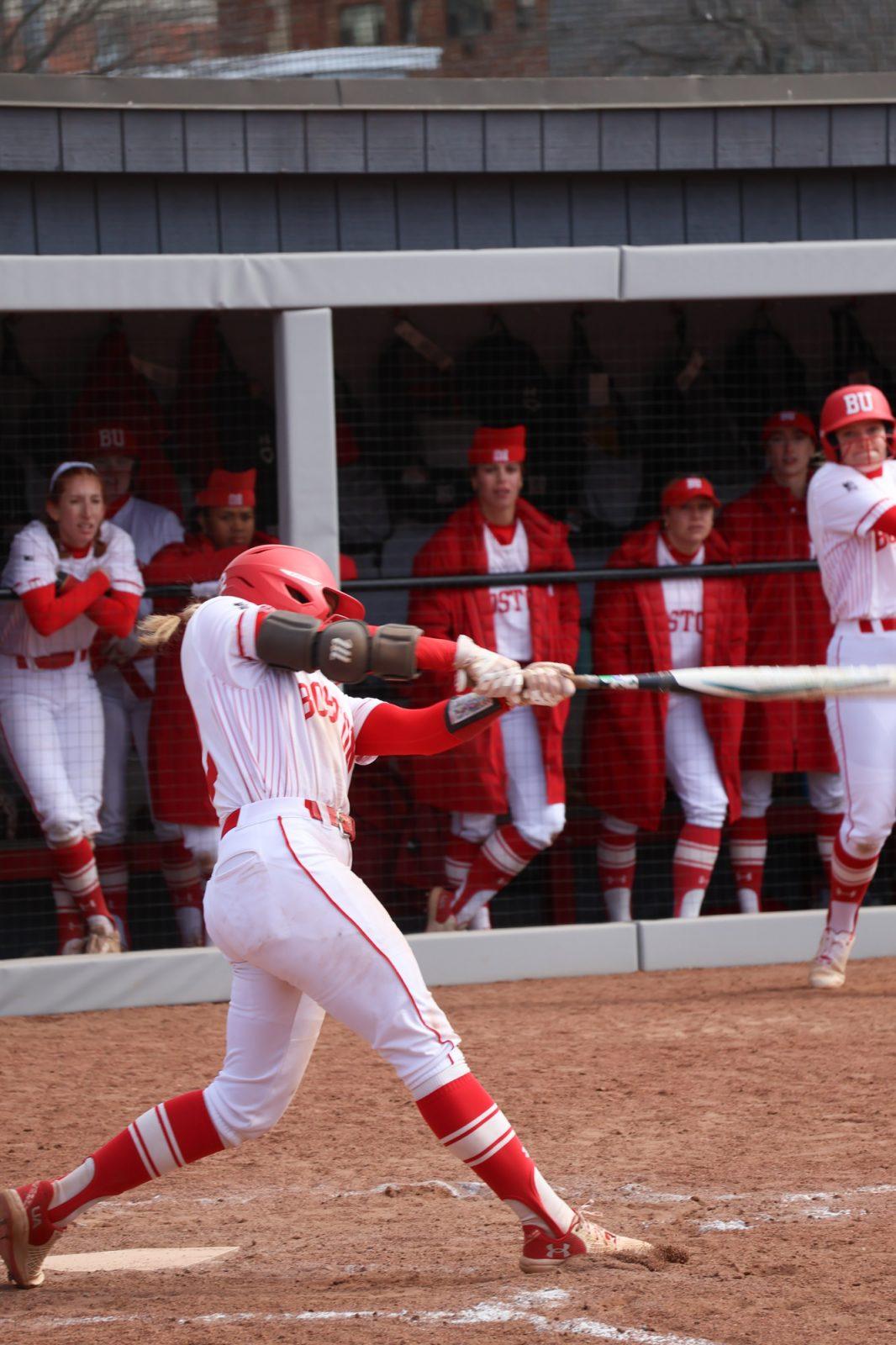The Boston University softball team leads the College of the Holy Cross 11-3 in the second game of a home doubleheader on a frigid and overcast late-March afternoon. Led Zeppelin’s “Kashmir” blasts through the one white speaker perched on the chain-link fence behind the home plate of the BU Softball Field as April Setterlund walks toward the batter’s box in the bottom of the third inning.
With the Terriers’ eighth win in nine games all but wrapped up, the only question remaining is whether Setterlund’s perfect day will continue. The junior center fielder is already 5-for-5 with three home runs and 11 RBIs on the day. Her two homers and six RBIs in Game 1 of the twin bill both tied school records.
The 5-foot-6 Setterlund puts up her bare hand to call time &- she lost her batting gloves freshman year and never bothered to replace them &- and calmly rakes the unkempt dirt in the lefty’s batter’s box with her cleats. She digs in her back foot and keeps her front heel raised. She rests her Easton Synergy bat on her back shoulder until pitcher Caitlin Belanger goes into her windup.
As the ball leaves Belanger’s hand, Setterlund raises the blue-and-white bat off her shoulder and slides her front foot forward. The Torrance, Calif., native then quickly spins away from the plate as the fastball zips within inches of her scarlet helmet.
Setterlund doesn’t even react. No nervous laugh. No smile. No deep breath. Most importantly, no backing off the plate. She’s gotten used to being brushed back. The brown-haired, ponytailed slugger plants her feet in the same fresh divots as before. Then she stares Belanger straight in the eye and thinks, “Throw it inside again.”
Belanger tries, but her fastball stays over the heart of the plate. Setterlund pounces. A ping, and then one collective “ooh” from the sparse crowd of just over 100. The ball soars over the arborvitae trees beyond the right-field fence before landing on Malvern Street.
The two-run bomb ties the same single-game home run record she had just matched two hours earlier. Her seven RBIs are a new record. A 5-for-5 showing the next day in another doubleheader against Dartmouth College would give her an 11-for-11 weekend and a nation-leading .597 batting average through 24 games.
“I don’t have a good enough vocabulary to do her weekend justice,” said BU coach Shawn Rychcik after his No. 3 hitter’s historic four-game run.
It all seems so natural for Setterlund at the plate &- her relaxed stance, her fluid swing, her strong follow-through. Lining balls into the gaps seems automatic. Driving a pitch over the fence seems effortless. It only seems that way, though.
The truth is that Setterlund was never supposed to be a power hitter. She wasn’t supposed to shatter the school’s single-season RBI record with 20 games still remaining or obliterate the school’s career doubles record by her junior year. She wasn’t supposed to be on pace to break the single-season home runs and slugging percentage records.
That’s because the speedy Setterlund had always been a slapper. She played head games with defenses. She’d square up to bunt before pulling the bat back, getting an Ichiro-like running start and poking the ball over the third baseman’s head.
Slappers don’t hit for power, and Setterlund didn’t. In fact, when Setterlund caught her first break in softball, she didn’t hit at all.
She was nine years old when her father, Tom, took her to a private hitting lesson for the first time. It was actually her older sister Adrienne’s lesson, but Adrienne couldn’t make it, so Tom took April instead.
The instructor, Phil Bruder, happened to coach a 10-and-under team that had already qualified for nationals, and it turned out he needed a pinch runner. After running a few drills outside, Setterlund had a spot on her first travel team.
She didn’t hit or play the field much on that team, but her quick feet had allowed her to get her foot in the door. Bruder told Tom that if April was serious about getting better, she needed regular playing time on a travel team.
“But she’s not really good now. Who’s gonna take her at 12-and-under?” Tom asked.
“Start your own team,” Bruder said. “I’ll help you get some players.”
So Tom did. With Bruder’s aid, he put together a team of 11-year-olds to compete against the best 12-and-under travel teams in southern California. It wasn’t pretty. The squad went five months before getting its first win.
“From September to December, we got our asses kicked by everybody,” Tom said.
But it wasn’t in vain, because Setterlund was rapidly improving. And it was during that season that she learned to slap.
Setterlund kept playing travel ball, her dad at her side the whole time. She got a three-week break after nationals in August and a three-week break for Christmas, but the other 46 weeks of the year, she was playing softball.
On weekends, the father-daughter team packed up the car on Friday afternoon, headed off to somewhere in southern California, Nevada or Arizona, and then returned late on Sunday.
“We were attached at the hip from the time she was nine until she went off to college,” Tom said. “Everybody else went to birthday parties, but she missed those parties. She played travel softball.”
As she got older, Setterlund was almost always the best player on her team and more often than not the best player in her league. In high school, she played for South Torrance High during school and a travel team called the Mizuno Pride during the summer. Every July, the Pride played in the Fireworks Recruiting Tournament in Aurora, Colo.
Rychcik attended that tournament every year, and in 2005, he successfully recruited pitcher Megan Currier, the daughter of Pride coach Lew Currier. The next summer, he tapped the Pride pipeline again by going after Setterlund. It wouldn’t be easy, though.
Despite the fact that Setterlund still didn’t have much power &- “Sophomore year of high school, I could barely get the ball out of the infield,” she said &- the speedster was being wooed by some of the top programs in the nation.
Two of her final three options were California State University-Fullerton and Northwestern University, both perennial top-25 programs that would give her a chance to compete for a College Softball World Series. The third was BU, a program that had never advanced past the regional championship.
Northwestern didn’t offer Setterlund a full scholarship, and with two kids already in college, her parents weren’t about to pick up the tab when the other two schools were offering full rides. So the Wildcats were eliminated.
Setterlund ultimately chose BU for a number of reasons &- Megan Currier had nothing but good things to say about the school and its facilities and coaches, and her brother Nels was living in Boston. But the biggest was that the school offered a better education than CSU-Fullerton, which the self-described “nerd” valued above all else.
“She didn’t care as much about excelling at softball as she did about getting a good education,” Tom said.
Her freshman year, Setterlund worked hard both in the classroom &- she earned America East Academic Honor Roll status &- and on the field &- she was named to the All-Conference First Team and garnered AE Rookie of the Year honors.
In fact, she worked so hard that she was almost always sore and tired.
“I had never really lifted or done any sort of rigorous training before,” Setterlund said. “When I got here, I wasn’t used to all the lifting and running we do.”
Once she got used to it, though, she found herself opening new doors on the diamond. She was still primarily a slapper, and she only hit one home run during her rookie campaign, but she was starting to drive the ball a lot more. As a result, she tied for the team lead with 12 doubles.
By the time her sophomore year rolled around, Setterlund was working harder than ever before, and she wasn’t getting worn down anymore. That is, until she suffered a stress fracture in her leg just before the season started.
The injury slowed her down &- she dropped from 14 stolen bases the year before to six &- but it wasn’t going to stop her. Setterlund hobbled her way to a team-leading .396 average and eight home runs and a program-record 15 doubles.
Why the spike in power? Setterlund wasn’t a slapper anymore. The combination of her ability to drive the ball (thanks to her increased strength) and her inability to beat out infield hits (thanks to her stress fracture) convinced her coaches that it was time for her to become a straight hitter.
“Coach said he’d rather have me hitting doubles than singles, so that was it,” Setterlund said.
It wasn’t easy at first. Sure, she didn’t have to worry about playing head games with the opposition any more, but it also meant the pitcher and defense didn’t have to guess at what Setterlund was going to do.
“It used to make me nervous because if I’m not swinging too well, it’s not like I can fake a bunt or slap,” she said. “It’s just, “OK, I have to fix my hitting.'”
Rychcik wasn’t worried at all, though.
“When you’re talking about an athlete like that, the adjustment time’s a lot quicker than probably any other athlete we’ve had here,” he said.
Setterlund’s outstanding season helped lead the Terriers to their second-ever NCAA regional championship appearance. Along the way, she collected All-Conference First Team honors again as well as All-America Third Team honors.
She was already well on her way to being one of the best players ever to grace the BU Softball Field, but she was going to have to be better still this season. The Terriers lost five of their nine starting hitters to graduation, including the lineup’s entire 3-4-5 combination.
Rychcik moved Setterlund from her usual spot as the leadoff or No. 2 hitter to the three-hole. She was now responsible for clearing the table rather than setting it.
She was also named a team captain, placing even more weight on her shoulders. None of it made any difference to Setterlund, though. She’s one of those players who puts more pressure on herself than anyone else possibly could.
After recovering from the stress fracture, she stayed in Boston over the summer and stepped up her training once again. She wasn’t going to be satisfied with matching her past success. She knew she could be even better.
“I’ve always had a drive to be as perfect as I can,” Setterlund said.
“I don’t even know if it’s possible,” said infielder and roommate Melanie Delgado, “but I think she’s worked even harder, which is completely baffling because she’s a hard worker to begin with. But she’s put in a lot of extra time in the weight room and on the field this season.”
Even while maintaining an over-.500 average &- she’s now at .524 &- Setterlund isn’t content.
“If she goes 2-for-3, she’s thinking about that one at-bat she didn’t get a hit,” her dad said.
That drive has carried Setterlund to the top of the AE stats sheet. She leads the conference in every &- yes, every &- offensive category.
Where will that drive carry Setterlund next? Two and a half weeks after the perfect weekend, her coach, now having had time to search his vocabulary, knows the answer.
“April will be the best player ever to play here,” Rychcik said. “She’ll shatter records when it’s all said and done. She might even break some NCAA records on the way.”




















































































































